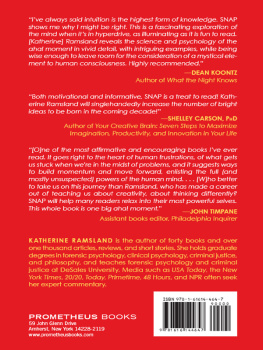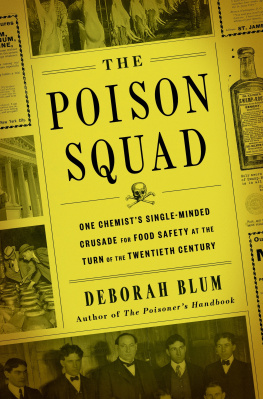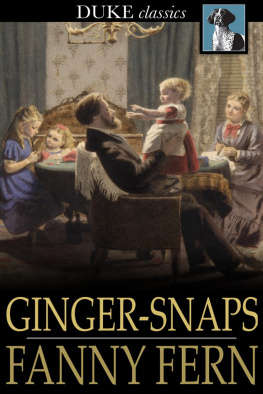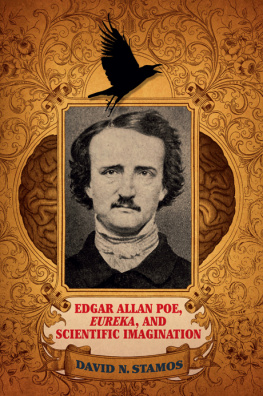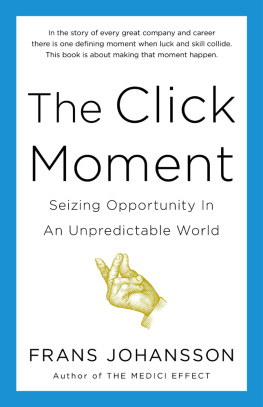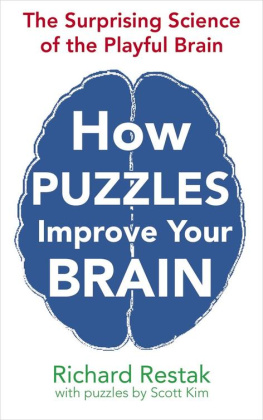
T he person to whom I'm most indebted for this book and my writing career is my agent, John Silbersack, because he urged me to do something unique, and he fully supported this project. He also gave me several terrific ideas for it.
Second, I thank my editor, Linda Greenspan Regan, for being so enthused about it.
I'm grateful to several people who assisted me in getting certain facts right, including Karen Walton, Rodger Berg, Zack Lysek, Lisa Getzler-Linn, Kevin Sullivan, Sir Alec Jeffreys, Alice Flaherty, and Ruth Osborne. Joel Katz, Dean Koontz, Rick Arlow, Zach Bloom, George Keeler, John Knific, Tom Carhart, Tim Marks, Patrick Clasen, and Josh Berman supplied some great personal stories, and I want to thank Deborah Blum for writing a terrific foreword. I also appreciate those who read the manuscript: Dean Koontz, John Timpane, and Shelley Carson.

It is not easy to convey, unless one has experienced it, the dramatic feeling of sudden enlightenment that floods the mind when the right idea finally clicks into place. One immediately sees how many previously puzzling facts are neatly explained by the new hypothesis. One could kick oneself for not having the idea earlier, it now seems so obvious. Yet before, everything was in a fog.
Francis Crick, What Mad Pursuit
A BRAIN ITCH
T he quote above refers to one of the world's most groundbreaking flash revelations: the structure of the DNA molecule. In 1953, Francis Crick, a British scientist, was working with James Watson, an American, at the University of Cambridge in England. Although biologists knew by the 1940s what comprised DNA, they did not yet know much about its appearance. As Watson and Crick tried to envision it, Watson read chemist Linus Pauling's unpublished paper about DNA. He believed that Linus was incorrect about its structure but that Watson failed to figure out a feasible alternative. A few days later, he saw an X-ray of the DNA crystal. The paired helix structure seemed eminently clear. Watson told Crick, and they commenced work on a model. Although they stalled a few times, they talked with colleagues who offered suggestions that helped spark several more revelatory insights. Things fell into place until they had a six-foot model that resembled a twisting ladder. This, they knew, was the appearance of that elusive molecule, DNA. In 1962, they received the Nobel Prize.
Their work demonstrates several important facets of the startling flash of full-bodied enlightenment that floods the mind. First, from years of immersion in that area of study, they were prepared for it. Second, they persisted. Third, they blended intimate isolation in a lab with collegial cross-fertilization. The dramatic pop of instant, fully formed knowledge that Crick described is a latent function of our brain's processing system. It needs preparation, but it's available to anyone. Although hard work is not required for snapping, experiencing snaps regularly and channeling them for specific purposes does involve training your brain.
Snaps or aha! moments often occur when, faced with ambiguity or a challenge, the brain clicks on something that instantly feels right. To try this process, read the following riddle and see if you can figure it out:
Gerald arrives at his local railway station to catch the Waterloo train, which departs hourly at exactly five minutes past the hour. Thinking he might have just missed it, he looks up at the station clock and sees that the hour and minute hands are both between 1 and 2. He's relieved that he hasn't missed his train. If the clock is correct, how does he know?
If you saw the solution right away, great! But it's often maddeningly elusive. The problem looks so simple that it should be obvious, and yet like other brain twisters, it can thwart your most determined efforts. When you do see it, whether quickly or after considerable effort, the solution will occur as a flashyou just see it. The clock's hands are both between the 1 and 2 of the 12, so it's exactly 12:00.
This is commonly called the aha! moment, the eureka experience, a brainstorm, a flash of genius, or an epiphany. It's a type of perceptual shift that some experience as an incandescent moment. The solution is obvious, even though you might not have found it. Trying to figure out such riddles is like looking for a specific book among many titles on a bookshelf. You know it's there, but you can't see it. Finally, you give up. Later, you go looking for another book, and the first one you originally wanted pops right out. It was there all the time. You just couldn't process it. That's how the brain often works with creative insight. It has resources that seem quite mysterious but are actually the result of how we prepare our minds.
A eureka moment can occur while working alone or during brainstorming sessions in groups. It could burst forth during isolated efforts or after seeing what someone else has done. There are so many applications for this magical link between impasse and enlightenment, whether in sports, business, art, science, industry, design, law enforcement, and even the military. We'll look at quite a few different applications in this book. In fact, the Nobel Prize itself came from a snap.
Alfred Nobel, the discoverer of the formula for dynamite, read a news article in 1888 that had confused him with his recently deceased brother. The reporter referred to Alfred as the Merchant of Death. This disturbed him. He did not wish to leave such a negative legacy. Pondering a way to be remembered for something good, the solution hit him. He could use the very thing that had inspired that dark moniker; he could apply the fortune that dynamite had given him to offer monetary prizes to people who had made a contribution to benefit the world. He made a will that bequeathed the money and died just a year later. On the third anniversary of his death, the first prizes were distributed in Stockholm, Sweden. The medal features a profile of Nobel.
There are many such stories. It was the remark by William Marston's wife about her blood pressure rising when she got angry or excited that inspired the precursor to the polygraph. The way Italians stood at a bar to drink their espressos, lattes, and cappuccinos inspired the creation of Starbucks. It was an Internet search that Jeff Bezos undertook for his hedge fund employer that inspired him to recognize the Internet itself as a solid investment opportunity. His boss wasn't interested, so he left his job and launched into the sale of books online. Thus, the hugely successful Amazon.com was born. A sudden insighta feeling of the right ideatriggered each of these ventures.
But let's be clear. This book is about more than just insight. It's about a specific type of aha! that I call a snap, because what I describe is closer to a spark that ignites action than to the mere recognition of the solution to a problem. A snap is insight plus momentum. Once the enlightenment occurs, it begs for action. It launches us forth, as it reportedly did for the renowned mathematician Archimedes.
THE FIRST AHA!
As the fable goes, in ancient Syracuse, Archimedes exemplified the eureka insight. For him, it was utter euphoria, an explosion of excitement that made him oblivious to the fact that he'd forgotten to dress before running through the streets proclaiming, Eureka! It was quite pressinga matter of life and death. Although it's difficult to know if the details of this tale are actually true (and some experts have disputed it), we do know enough about Archimedes to believe that it
Next page
